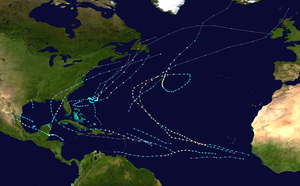| Timeline of the 2000 Atlantic hurricane season | |||||
|---|---|---|---|---|---|
 Season summary map | |||||
| Season boundaries | |||||
| First system formed | June 7, 2000 | ||||
| Last system dissipated | October 19, 2000 | ||||
| Strongest system | |||||
| Name | Keith | ||||
| Maximum winds | 140 mph (220 km/h) (1-minute sustained) | ||||
| Lowest pressure | 939 mbar (hPa; 27.73 inHg) | ||||
| Longest lasting system | |||||
| Name | Alberto | ||||
| Duration | 19.75 days | ||||
| |||||
The 2000 Atlantic hurricane season was an event in the annual tropical cyclone season in the north Atlantic Ocean. There was above-normal activity during the season,[nb 1] with nearly all its activity occurring during a three-month period, August–October.[2] The season officially began on June 1, 2000 and ended on November 30, 2000. These dates, adopted by convention, historically describe the period in each year when most tropical systems form.[3] Although two tropical depressions formed in June, the first named storm, Alberto, did not arise until August 4. The season's final storm, an unnamed subtropical storm, became extratropical on October 29.
The 2000 season produced 15 cyclones of at least tropical (14) or subtropical (1) storm strength. Four of the tropical storms became hurricanes, of which three developed into major hurricanes.[nb 2] There were also four depressions that failed to reach tropical storm strength. The two most significant storms of the season, in terms of loss of life and damage, were Hurricanes Gordon and Keith. Gordon made land fall in the eastern Yucatán Peninsula, traversed the Gulf of Mexico, and made landfall along the Gulf Coast of the United States. Keith made landfall in Belize, crossed the Yucatán, moved over the Gulf, and made landfall in northeastern Mexico.[2] Following the 2000 season, the name Keith was retired from reuse in the North Atlantic by the World Meteorological Organization.[5]
This timeline documents tropical cyclone formations, strengthening, weakening, landfalls, extratropical transitions, and dissipations during the season. It includes information that was not released throughout the season, meaning that data from post-storm reviews by the National Hurricane Center, such as a storm that was not initially warned upon, has been included.
By convention, meteorologists one time zone when issuing forecasts and making observations: Coordinated Universal Time (UTC), and also use the 24-hour clock (where 00:00 = midnight UTC).[6] In this time line, all information is listed by UTC first with the respective local time included in parentheses.
- ^ "Background Information: North Atlantic Hurricane Season". College Park, Maryland: NOAA Climate Prediction Center. Retrieved July 14, 2020.
- ^ a b Franklin, James J.; Avila, Lixion A.; Beven, Jack L.; Lawrence, Miles B.; Pasch, Richard J.; Stewart, Stacy R. (December 2001). "Atlantic Hurricane Season of 2000". Monthly Weather Review. 129 (12). American Meteorological Society: 3037–3056. Bibcode:2001MWRv..129.3037F. doi:10.1175/1520-0493(2001)129<3037:AHSO>2.0.CO;2. S2CID 122546534. Retrieved July 14, 2020.
- ^ Dorst, Neal (June 1, 2018). "Hurricane Season Information". Frequently Asked Questions About Hurricanes. Miami, Florida: NOAA Atlantic Oceanographic and Meteorological Laboratory. Retrieved July 14, 2020.
- ^ "Saffir-Simpson Hurricane Wind Scale". nhc.noaa.gov. Miami Florida: NOAA National Hurricane Center. Retrieved July 14, 2020.
- ^ "Tropical Cyclone Naming History and Retired Names". miami, Florida: NOAA National Hurricane Center. Retrieved July 15, 2020.
- ^ "Understanding the Date/Time Stamps". miami, Florida: NOAA National Hurricane Center. Retrieved July 14, 2020.
Cite error: There are <ref group=nb> tags on this page, but the references will not show without a {{reflist|group=nb}} template (see the help page).